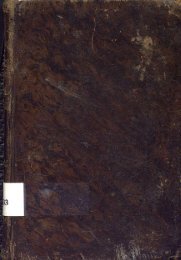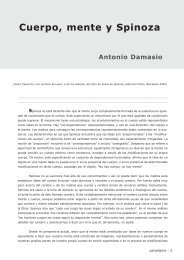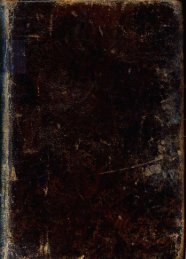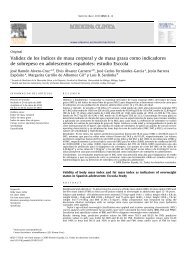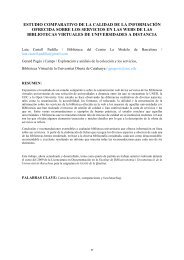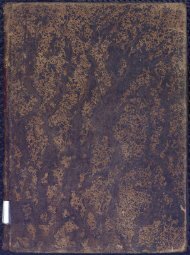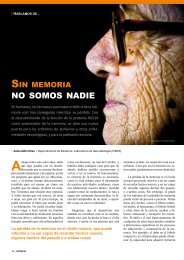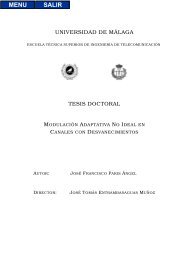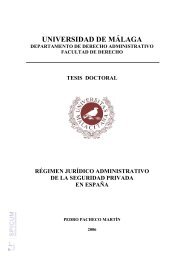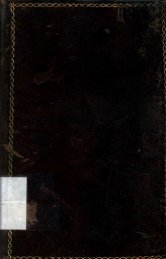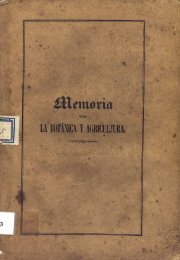Papel de las actividades superóxido dismutasa y catalasa en la ...
Papel de las actividades superóxido dismutasa y catalasa en la ...
Papel de las actividades superóxido dismutasa y catalasa en la ...
Create successful ePaper yourself
Turn your PDF publications into a flip-book with our unique Google optimized e-Paper software.
Journal of Fish Diseases 2003, 26, 305–308<br />
Short communication<br />
Survival against exog<strong>en</strong>ous hydrog<strong>en</strong> peroxi<strong>de</strong> of<br />
Photobacterium damse<strong>la</strong>e subsp. piscicida un<strong>de</strong>r differ<strong>en</strong>t<br />
culture conditions<br />
P Díaz-Rosales, M Chabrillón, M A Moriæigo and M C Balebona<br />
Departm<strong>en</strong>t of Microbiology, Faculty of Sci<strong>en</strong>ces, University of Má<strong>la</strong>ga, Spain<br />
Keywords: culture, hydrog<strong>en</strong> peroxi<strong>de</strong>, Photobacterium<br />
damse<strong>la</strong>e subsp. piscicida, survival.<br />
Photobacterium damse<strong>la</strong>e subsp. piscicida is a fish<br />
pathog<strong>en</strong> responsible for important losses in aquaculture<br />
world-wi<strong>de</strong>. Several studies on its virul<strong>en</strong>ce<br />
mechanisms have be<strong>en</strong> carried out and outer<br />
membrane proteins involved in the acquisition of<br />
iron or production of extracellu<strong>la</strong>r products have<br />
be<strong>en</strong> suggested as the main <strong>de</strong>terminants of its<br />
virul<strong>en</strong>ce for fish (Magariños, Santos, Romal<strong>de</strong>,<br />
Rivas, Barja & Toranzo 1992; Magariños, Romal<strong>de</strong>,<br />
Lemos, Barja & Toranzo 1994). However, the actual<br />
methods of invasion and survival insi<strong>de</strong> the host are<br />
still unknown and while some authors have reported<br />
the pres<strong>en</strong>ce of intact bacteria insi<strong>de</strong> fish cells,<br />
suggesting the ability of the bacterium to survive<br />
as an intracellu<strong>la</strong>r pathog<strong>en</strong> (Noya, Magariños,<br />
Toranzo & Lamas 1995; López-Dóriga, Barnes,<br />
dos Santos & Ellis 2000), others have observed that<br />
this pathog<strong>en</strong> is highly susceptible to oxidative<br />
radicals g<strong>en</strong>erated during the macrophage respiratory<br />
burst (Skarmeta, Bandín, Santos & Toranzo<br />
1995; Barnes, Balebona, Horne & Ellis 1999a).<br />
Reactive oxyg<strong>en</strong> species (ROS) such as hydrog<strong>en</strong><br />
peroxi<strong>de</strong> and superoxi<strong>de</strong> are g<strong>en</strong>erated during the<br />
macrophage respiratory burst in response to microbial<br />
infection. Bacterial pathog<strong>en</strong>s must overcome<br />
the toxic effects of ROS to establish infections.<br />
Correspon<strong>de</strong>nce Dr M C Balebona, Departm<strong>en</strong>t of Microbiology,<br />
Faculty of Sci<strong>en</strong>ces, University of Ma<strong>la</strong>ga, Campus<br />
Teatinos, 29071 Ma<strong>la</strong>ga, Spain<br />
1 (e-mail: balebona@uma.es)<br />
Production of superoxi<strong>de</strong> dismutase and cata<strong><strong>la</strong>s</strong>e<br />
<strong>en</strong>zymes, which <strong>de</strong>compose superoxi<strong>de</strong> and peroxi<strong>de</strong><br />
radicals, respectively, have be<strong>en</strong> reported to<br />
contribute to the virul<strong>en</strong>ce of a number of<br />
pathog<strong>en</strong>s (Franzon, Aron<strong>de</strong>l & Sansonetti 1990;<br />
Lefebre & Valvano 2001; Uzzau, Bossi & Figueroa-<br />
Bossi 2002). Thus, the ability of cata<strong><strong>la</strong>s</strong>e to<br />
<strong>de</strong>compose peroxi<strong>de</strong> radicals increases survival of<br />
bacteria in the pres<strong>en</strong>ce of peroxi<strong>de</strong>.<br />
In addition, increased levels of cata<strong><strong>la</strong>s</strong>e activity<br />
wh<strong>en</strong> bacteria are cultured un<strong>de</strong>r certain conditions,<br />
such as the pres<strong>en</strong>ce of peroxi<strong>de</strong> radicals or until<br />
the stationary phase, have be<strong>en</strong> reported (Stortz,<br />
Tartaglia & Ames 1990; Loew<strong>en</strong> 1997). Moreover,<br />
the fact that most cata<strong><strong>la</strong>s</strong>es are iron-cofactored<br />
suggests that growth un<strong>de</strong>r differ<strong>en</strong>t iron conc<strong>en</strong>trations<br />
may have some effect on this <strong>en</strong>zyme activity.<br />
Cata<strong><strong>la</strong>s</strong>e activity has be<strong>en</strong> reported in P. damse<strong>la</strong>e<br />
subsp. piscicida (Barnes et al. 1999a), however, the<br />
role of this <strong>en</strong>zyme in the protection against<br />
peroxi<strong>de</strong> has not yet be<strong>en</strong> <strong>de</strong>termined. For this<br />
reason, the resistance to peroxi<strong>de</strong> radicals of<br />
P. damse<strong>la</strong>e subsp. piscicida cells grown un<strong>de</strong>r iron<br />
limited and replete conditions, and pulsed with<br />
hydrog<strong>en</strong> peroxi<strong>de</strong>, has be<strong>en</strong> evaluated in this study.<br />
Two strains of P. damse<strong>la</strong>e subsp. piscicida have<br />
be<strong>en</strong> inclu<strong>de</strong>d in this study. The virul<strong>en</strong>t strain<br />
(Lg41/01) (LD 50 ¼ 2.2 · 10 4 CFU g )1 ) was iso<strong>la</strong>ted<br />
from diseased sole, Solea s<strong>en</strong>egal<strong>en</strong>sis Kaup,<br />
showing typical signs of pseudotuberculosis, and<br />
the non-virul<strong>en</strong>t strain (Epoy) (LD 50 ><br />
1.0 · 10 8 CFU g )1 ; Magariños, Bonet, Romal<strong>de</strong>,<br />
Martínez, Congregado & Toranzo 1996) kindly<br />
supplied by Dr K. Muroga (Faculty of Applied<br />
Ó 2003<br />
B<strong>la</strong>ckwell Publishing Ltd<br />
305



